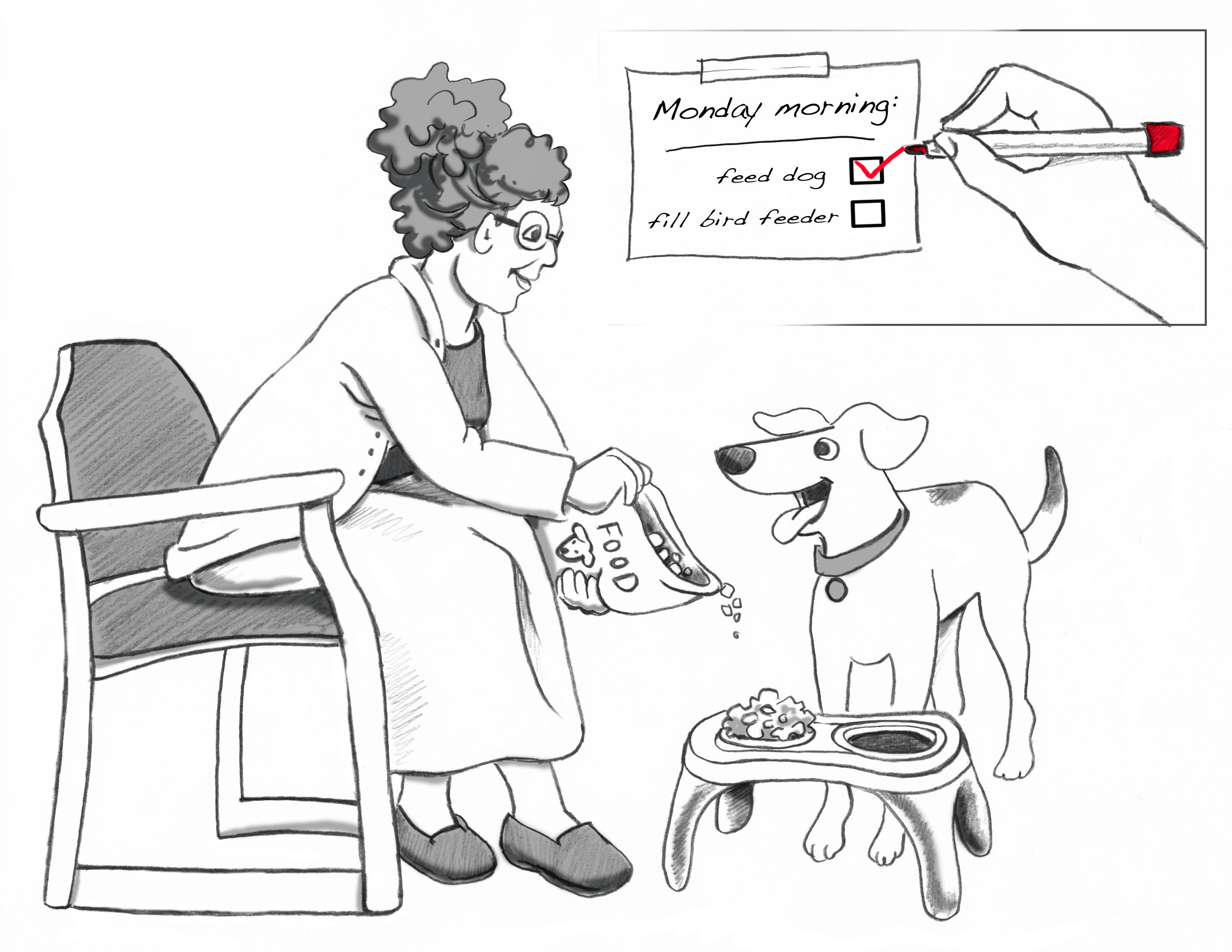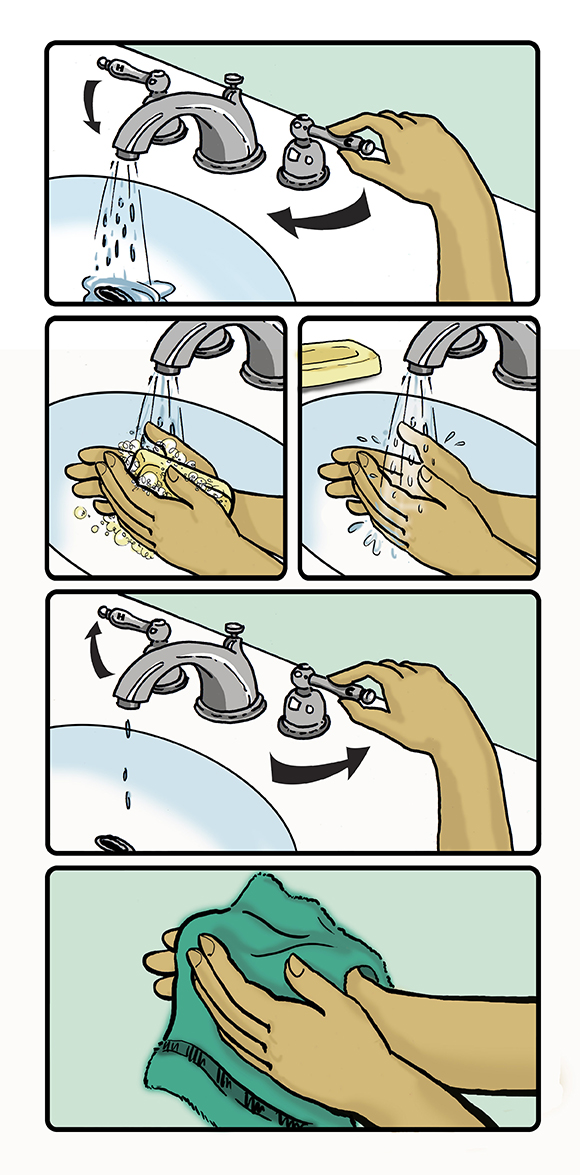The Power of Purpose
 We all need a reason to get out of bed each day. People with dementia need to know their life has meaning and purpose.
We all need a reason to get out of bed each day. People with dementia need to know their life has meaning and purpose.
Moments We Relate To
In Carol’s role as a mother, cooking and setting the table each evening was an essential activity. However, setting the table had became too confusing for Carol. So, we created laminated placemats with a template showing a plate, napkin, fork, knife, spoon and cup. Using the templates, Carol knew exactly where to put each item to set the table again. This helped Carol feel like she had meaning and purpose, and gave her an activity to do while her care partner made dinner.
Sound familiar? Everyone goes through similar challenges, but the way we need to approach them may be different. Let’s get started finding your just right.
The Power of Purpose
We all ask the same fundamental questions:
-
Who am I? (activities)
-
What is my purpose? (role)
-
Where do I fit in the universe? (community)
Role and place in the universe are some of the first things the community takes away from a person with dementia. We do not do this on purpose. We see a person struggling, and we want to help them, so we do things for them. We also want to keep them safe, and we do not want them to be frustrated by being asked to do things that they are now having a hard time with. However, since roles and activities are so essential to those three fundamental questions of life, we want to figure out how to maintain them.
Written by Jennifer Brush, MA, CCC/SLP
 Roles
Roles
A role is something that gives us purpose or defines who we are within a community, situation or relationship. People with dementia need roles and activities to keep their sense of purpose, belonging and meaning in life. In Hand in Hand care, we help the person with dementia maintain roles or find new roles that are accessible to them. A simple example of a role is the role of being a parent. An activity that goes along with that role may be playing catch with a child. We often need to simplify or break down tasks so people with dementia can do the activity with greater success.
Task Breakdown: Step-by-Step
Task breakdown is the process of helping a person successfully participate in or complete an activity by making it a step-by-step process. Remember earlier when we said that we want to avoid taking away roles and activities from a person with dementia? Task breakdown is one of the main techniques that allows us to maintain roles and activities for our loved one with dementia.
Often when reading about dementia care, we are told about all of the things a person with dementia can no longer do.
For example, it is often assumed that a person with dementia can no longer wash their hands because when some people with dementia go to the bathroom, they do not wash their hands. Maybe we remind them to wash their hands and they still don’t do it. Why might this be happening? People with dementia often become confused when there are many steps in a sequence. You and I may not think that there are very many steps in the sequence of washing your hands, but there are:

- Walk to the sink.
- Figure out which handle is the cold water.
- Turn the handle to the right.
- Put your hands under the water to wet them.
- Find out which thing on the sink is the soap.
- Press the soap pump or pick up the soap.
- Rub the soap between your hands.
- Rinse your hands under the water.
- Turn the water off by finding the correct handle again and turn it to the left.
- Find a towel.
- Dry your hands with the towel.
That is 11 steps to wash your hands!
Think about all of the common tasks we complete every single day. We shower, make our bed, get dressed, fix our meals, etc. Each one of these tasks has multiple steps. A person with dementia can experience a breakdown during any of these steps. When you notice someone having trouble with something you think is simple, pause a moment, be patient, try to figure out which step caused trouble or confusion.
When we break an activity into its individual steps and present one step at a time, people with cognitive impairment are more likely to achieve success.
We can do this by writing out the steps to the task, as I did with washing your hands above. Then we demonstrate the whole process ourselves and ask the person to then wash their hands. Some people will be able to mimic the task after they see you do the whole thing, and other people may not be able to. For some people, you may need to demonstrate each step and ask them to follow it immediately after seeing you. Another great form of task breakdown that can allow for more independence by providing cues is creating signs that show, visually and with words, the steps of a task.
Providing supports in activities that make them more likely to be done correctly, such as:
- Providing an outline of a place setting onto a placemat, indicating where to put the plate, napkin, fork, knife and cup.
- When cooking together, only put out the items needed for one part of the recipe. For example, when you are ready to stir chocolate chips into cookies, do not leave sugar and flour out on the table because the person may think they still need to add the flour.
- Providing step-by-step written and visual instructions to washing your hands next to the sink.
Traditional Care
- A person with dementia is given meals chosen by their care partner.
- A person with dementia likes to garden, but they can no longer get down on their knees to do so. Gardening is no longer an option for them.
- A person with dementia tries to read Sherlock Holmes, gets upset and says they can’t read it. It is assumed the person can no longer read, and books are no longer offered to them.
- At a dinner party, a person with dementia gets up from the table, storms out of the room and tries to leave the house. People assume this is because of the dementia and stop having them over for dinner.
- A person with dementia does not go to the bathroom, despite being reminded to do so. It is assumed they are incontinent and are put in adult diapers.
- A person with dementia continually insists that their daughter is coming home from school, and they need to make cookies for her. The care partner keeps reminding the person that their daughter is 45 years old now and not coming home from school. This creates arguments and confusion.
- A person with dementia can no longer follow a recipe and is told they can no longer cook.
Hand in Hand
- A person with dementia is presented with two or more options for a meal and can choose the one they would like. (See “The Power of Choice”)
- Care partners create a prepared environment on a table in the home with a few plants on it, a watering can and a sign on the table that says, “Please water the plants.” (See “The Power of Purpose”)
- Care partners try books with larger type and/or give the person with dementia books with fewer lines per page to read so the text is less confusing. (See “The Power of Purpose”)
- Care partners observe the situation and discover that the person with dementia was confused by the number of people in the room, the music playing in the background, and multiple food items on the table. At the next dinner event, they turn off the music, try not to all talk at once, and only put out the plate of food the person will be eating from. (See “Clutter and Noise” in “Setting Up Your Home”)
- Care partners observe and notice that the bathroom door is always shut, so the person with dementia cannot see the bathroom and thus does not know where it is. The bathroom door is kept open when not in use, and signage is used to indicate where the bathroom is, from whatever room of the house the person is in. (See “Setting Up Your Home”)
- The care partner validates the care and love the person with dementia has for their daughter. They ask what the daughter’s favorite cookies are and offer to make those cookies together.(See “The Power of Communication”)
- Care partners find simplified recipes and write out step-by-step instructions. The care partner guides the person with dementia to follow along with them or on their own. (See “Making the Day Easier, One Step at a Time”)
Why It Matters
- A person with dementia wants to be able to make decisions about their own life. Providing choice at mealtime decreases feelings of loss of self and increases trust and respect in the care partner relationship.
- Providing gardening brings back meaning and purpose into the person’s life. It also fulfills the desire to maintain a role in life and provides an activity for engagement, which decreases boredom.
- Reading provides opportunity for meaningful activity and engagement throughout the day. Providing activities and engagement in an accessible way decreases concerning behaviors caused by boredom and anxiety.
- Preparing the environment by decreasing noise and distraction reduces anxiety and thus decreases concerning behaviors. This also enables the person to continue to come to family events and be a part of their community.
- With increased signage and visibility of the bathroom, the person with dementia can be more independent. This also decreases care partner workload.
- This meets the true need behind the behavior and recognizes the person’s emotions. This decreases the constant questioning and agitation.
- Making cooking accessible provides meaning, purpose, role and a way to give back to their community. It also provides activity during the day, which decreases anxiety and boredom.
Hand in Hand at Home
There are simple things you can do to transform your home into a supportive place that helps your loved one with dementia function better. We are going to show you just how to do it.
What is Dementia?
Dementia isn't a specific disease. Instead, dementia describes a group of symptoms affecting memory, thinking and social abilities severely enough to interfere with daily functioning.
Transforming Your Home
The best home environment is one that supports the abilities of the people living there. Small changes in lighting, color, contrast, cueing, clutter, and noise can make a big difference.
Declutter
Understand the negative impact of clutter and take steps to improve the home environment.
Enhance Lighting
Simple changes in lighting can be made in the home to help your loved one function more independently and sleep better.
Support Memory
Create a memory center in your home to reduce confusion and foster wellbeing.
Communicate Effectively
Use a style of communication that is easier for the person with dementia to understand and follow conversations.
Understand Behaviors
Make sense of unexpected behaviors and learn how to prevent them.
Walking About
Tips for understanding and preventing walking about as well as information about how to choose a locating device.
The Power of Choice
Given them every opportunity to make informed choices about their care, leisure time, clothing, food and anything else that affects their life.
Power of Purpose
We all need a reason to get out of bed each day. People with dementia need to know their life has meaning and purpose.
Hiring Home Care
Learn how to ease the transition to additional care partners find out what questions to ask.
Self-Care
Advice for taking care of yourself, learning how and where to ask for help and scheduling breaks from caregiving.
Get Started!
You can do this! Take one step at a time. Follow these steps to get started.



